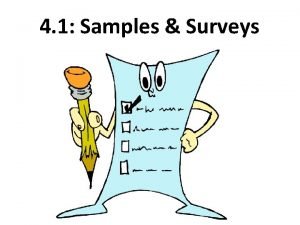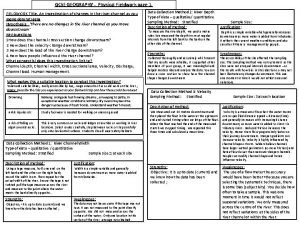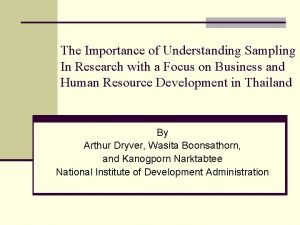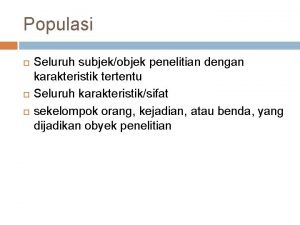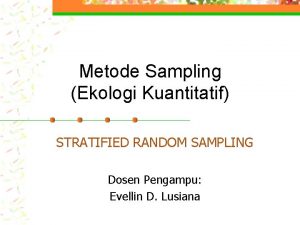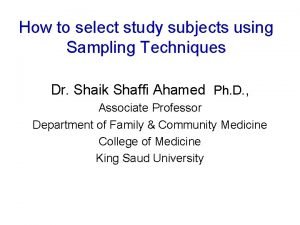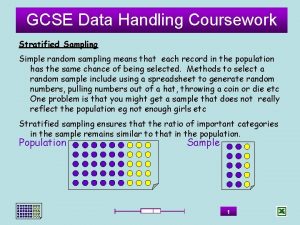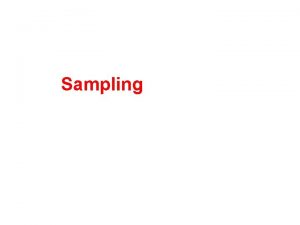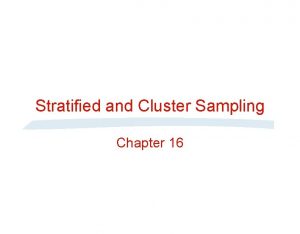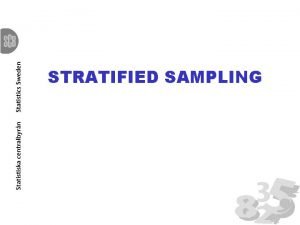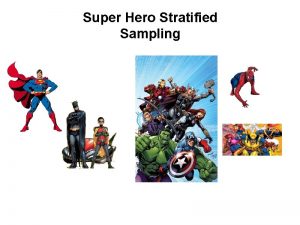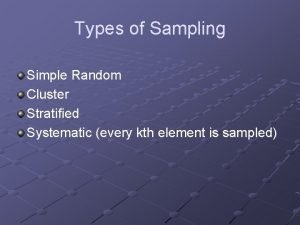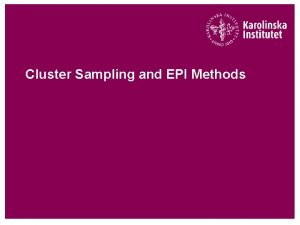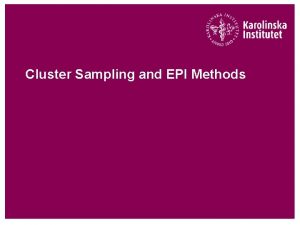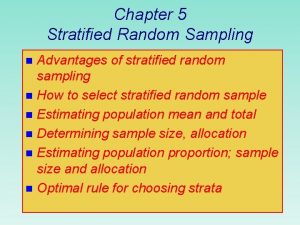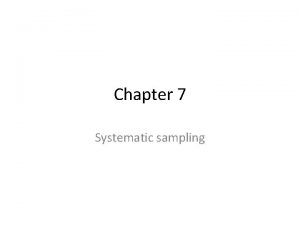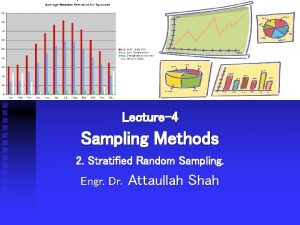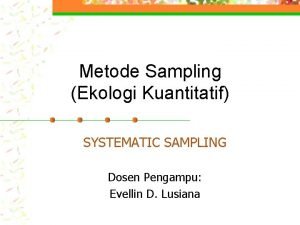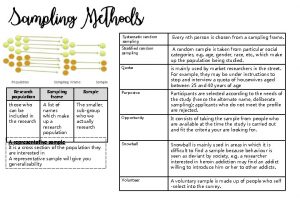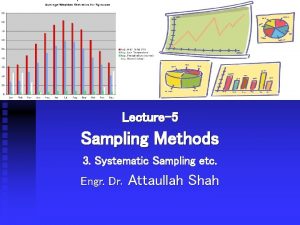2 2 Systematic Stratified and Cluster Sampling Copyright


















- Slides: 18

2. 2 Systematic, Stratified, and Cluster Sampling Copyright © 2016 Pearson Education, Inc. Slide 1

Systematic sampling To perform systematic sampling, we randomly select an individual out of the first k individuals and also select every kth individual after the first selected individual. Copyright © 2016 Pearson Education, Inc. Slide 2

Example: Design a Plan to Perform Systematic Sampling A grocery store owner wants to survey customers as they leave the store on a certain day. There about 470 customers each day. The owner would like to get feedback from at least 40 customers. From past experience, she knows that if 60 customers are approached, about 40 of them will participate in the survey. Design a plan to select a sample. Copyright © 2016 Pearson Education, Inc. Slide 3

Solution First we divide 470 by 60 which is 7. 8. If we round 7. 8 up to 8 and approach every 8 th person, the number of people approached would be only be about (58 people). But that would not meet the owner’s goal to approach 60 people. If we round 7. 8 down to 7 and approach every 7 th customer, the number of people approached would be about 67 people, which meets the owner’s goal. So, every 7 th customer should be approached. Copyright © 2016 Pearson Education, Inc. Slide 4

Solution To determine the first individual, we randomly select a number between 1 and 7, inclusive. Using the seed 58 (the current temperature outside the author’s home when writing this paragraph) with a TI-84, we obtain the number 2. So, the pollster should approach the 2 nd customer and every 7 th customer after that: 2, 2 + 7 = 9, 9 + 7 = 16, 16 + 7 = 23, 23 + 7 = 30, … So, the pollster should approach the 2 nd customer, the 9 th customer, the 16 th customer, the 23 rd customer, the 30 th customer, and so on. Copyright © 2016 Pearson Education, Inc. Slide 5

Stratified sampling To perform stratified sampling, a population is divided into subgroups called strata (singular: stratum) and simple random sampling is performed on each stratum. In each stratum, the individuals share some characteristic. The ratios of the number of individuals selected from each stratum are equal to the corresponding ratios of the stratum sizes. Copyright © 2016 Pearson Education, Inc. Slide 6

Cluster sampling To perform cluster sampling, a population is divided into subgroups called clusters. Then simple random sampling is used to select some of the clusters. All of the individuals in those selected clusters form the sample. Copyright © 2016 Pearson Education, Inc. Slide 7

Example: Designing a Plan to Perform Cluster Sampling The president of a college would like professors to survey 1000 of the college’s 35, 000 students about their awareness of various services available on campus. Although the president would like the survey to be administered during class time, she would prefer that it not disrupt all classes. Assuming that the smallest class size is 20 students, design a survey plan. Copyright © 2016 Pearson Education, Inc. Slide 8

Solution Simple random sampling, systematic sampling, and stratified sampling would disrupt a lot of classes. If each class is treated as a cluster, then cluster sampling would disrupt far fewer classes. The first step would be to create a frame of all classes. Then simple random sampling can be used to select the classes. To determine the number of classes that should be selected, we divide the desired sample size, 1000 students, by the smallest class size, 20 students: 1000 ÷ 20 = 50 classes. All the students in those 50 classes should be surveyed. Copyright © 2016 Pearson Education, Inc. Slide 9

Solution The sample size will likely turn out to be more than the desired size of 1000 students because the minimum class size was used to calculate how many classes should be selected. To use a larger class size to perform the calculation runs the risk of ending up with fewer students than the desired sample size. Copyright © 2016 Pearson Education, Inc. Slide 10

Requirements and Benefits of Sampling Methods Copyright © 2016 Pearson Education, Inc. Slide 11

Convenience sampling To perform convenience sampling, we gather data that are easy to collect and do not bother with collecting them randomly. Copyright © 2016 Pearson Education, Inc. Slide 12

Voluntary response sampling To perform voluntary response sampling, we let individuals choose to be in the sample. Copyright © 2016 Pearson Education, Inc. Slide 13

Example: Identifying Sampling Methods Identify whether the sampling method is simple random, systematic, stratified, cluster, or convenience. Explain. 1. A researcher randomly selects 20 Taco Bell locations and surveys all the employees at those locations. 2. A news station hosts a call-in survey about whether physician-assisted death should be legalized in all states. 3. A researcher randomly selects an LED TV out of the first 200 LED TVs on an assembly line and also selects every 200 th LED TV after that. Copyright © 2016 Pearson Education, Inc. Slide 14

Example: Identifying Sampling Methods Identify whether the sampling method is simple random, systematic, stratified, cluster, or convenience. Explain. 4. In a study at a community college, 30 instructors are randomly selected from fulltime instructors and 50 instructors are selected from part-time instructors. 5. The City Hall of Spring Hill, Kansas, creates a frame of its 5730 residents and randomly selects 60 residents. Copyright © 2016 Pearson Education, Inc. Slide 15

Solution 1. A researcher randomly selects 20 Taco Bell locations and surveys all the employees at those locations. Because all the employees at 20 clusters were surveyed, cluster sampling was performed. 2. A news station hosts a call-in survey about whether physician-assisted death should be legalized in all states. A call-in survey would involve only those who choose to call in. So, the station performed voluntary response sampling, which is one type of convenience sampling. No type of convenience sample should ever be performed. Copyright © 2016 Pearson Education, Inc. Slide 16

Solution 3. A researcher randomly selects an LED TV out of the first 200 LED TVs on an assembly line and also selects every 200 th LED TV after that. Because every 200 th TV was selected, systematic sampling was performed. 4. In a study at a community college, 30 instructors are randomly selected from fulltime instructors and 50 instructors are selected from part-time instructors. Because instructors were randomly selected from (two) strata, stratified sampling was performed. Copyright © 2016 Pearson Education, Inc. Slide 17

Solution 5. The City Hall of Spring Hill, Kansas, creates a frame of its 5730 residents and randomly selects 60 residents. Because the residents were randomly selected from a single frame, simple random sampling was performed. Copyright © 2016 Pearson Education, Inc. Slide 18
 Systematic sampling disadvantages
Systematic sampling disadvantages Cluster sample vs stratified
Cluster sample vs stratified Cluster sampling vs stratified sampling
Cluster sampling vs stratified sampling Quota sampling definition and example
Quota sampling definition and example Demand characteristics
Demand characteristics Disadvantage of stratified sampling
Disadvantage of stratified sampling Jenis jenis sampel
Jenis jenis sampel Stratified sampling adalah
Stratified sampling adalah Stratified sampling physical geography
Stratified sampling physical geography Stratified sampling formula
Stratified sampling formula Simple random sampling adalah
Simple random sampling adalah Stratified random sampling adalah
Stratified random sampling adalah Alokasi neyman
Alokasi neyman Application of statistics
Application of statistics Purposive sampling
Purposive sampling Data handling gcse
Data handling gcse What is a stratified sampling
What is a stratified sampling Consecutive sampling
Consecutive sampling Cluster sampling advantages and disadvantages
Cluster sampling advantages and disadvantages





